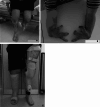Occurrence of Malformations of the Upper Extremity in Tibial Hemimelia: Correlation with the Jones Classification
- PMID: 40321490
- PMCID: PMC12044120
- DOI: 10.1007/s43465-025-01359-9
Occurrence of Malformations of the Upper Extremity in Tibial Hemimelia: Correlation with the Jones Classification
Abstract
Background: Tibial hemimelia is a rare malformation with a wide clinical spectrum of presentation. The severity of this condition can be typed using different classification systems. It can exist as an independent entity or can be associated with upper limb or visceral malformations. The aims of our study are therefore, a. to report the incidence of upper limb deformities in relation to the severity of tibial hemimelia classified by the Jones classification, b. incidence of tibial hemimelia as a part of a syndrome c. to report the overall incidence of the associated upper limb and visceral deformities.
Methods: A retrospective study was done using radiographs and clinical notes. The severity of the tibia deformity was assessed using the Jones classification. The clinical notes were reviewed to report the additional findings in the upper limbs and the visceral organs.
Results: The study included 69 patients with tibial hemimelia aged from 10 months to 34 years. Twenty of them (28.9%) had bilateral involvement. Additional malformations were observed in 56 patients (81%) involving the upper and lower limb and visceral organs. In 11 patients (16%), tibial hemimelia occurred as part of a syndrome, most often being Gollop-Wolfgang complex. The incidence of malformations of the upper extremities was 15 (21.7%), four of which (26.6%) involved bilateral upper extremity malformation. The cleft hand was the most frequent malformation of the upper extremities, followed by hypoplasia or aplasia of the thumb and fingers.
Conclusion: Jones type I tibial hemimelia is often associated with visceral and upper limb malformations. visceral anomalies are associated with syndromal forms of Tibiail hemimelia. Several forms of upper limb malformations with varying severity were associated with the disorder. Therefore, a holistic approach to the patient should be initiated soon after birth involving a paediatric, hand and visceral surgeon, to provide the best possible care.
Level of evidence: Level IV study, retrospective review of 69 patients with tibial hemimelia.
Keywords: Classification; Jones classification; Limb malformation; Syndrome; Tibial aplasia; Tibial hemimelia; Upper limb.
© The Author(s) 2025.
Conflict of interest statement
Conflict of interestNone.
Figures


Similar articles
-
Asymmetric limb lengthening in the treatment of tibial hemimelia caused by osteomyelitis: A case report.Medicine (Baltimore). 2019 Jan;98(3):e14031. doi: 10.1097/MD.0000000000014031. Medicine (Baltimore). 2019. PMID: 30653110 Free PMC article.
-
Femoral bifurcation and bilateral tibial hemimelia: case report.Pan Afr Med J. 2018 Jun 5;30:99. doi: 10.11604/pamj.2018.30.99.11969. eCollection 2018. Pan Afr Med J. 2018. PMID: 30344883 Free PMC article.
-
A rare case of limb deficiency syndrome: Gollop WolfGang syndrome.Radiol Case Rep. 2021 Jun 8;16(8):2053-2055. doi: 10.1016/j.radcr.2021.05.025. eCollection 2021 Aug. Radiol Case Rep. 2021. PMID: 34158891 Free PMC article.
-
Systematic radiographic evaluation of tibial hemimelia with orthopedic implications.Pediatr Radiol. 2017 Apr;47(4):473-483. doi: 10.1007/s00247-016-3730-8. Epub 2017 Jan 3. Pediatr Radiol. 2017. PMID: 28050636 Review.
-
Deformity Reconstruction Surgery for Tibial Hemimelia.Children (Basel). 2021 May 31;8(6):461. doi: 10.3390/children8060461. Children (Basel). 2021. PMID: 34072809 Free PMC article. Review.
References
-
- Weber, M., Schröder, S., Berdel, P., et al. (2005). Nation-wide registration of limb deficiencies in Germany. Zeitschrift fur Orthopadie und Ihre Grenzgebiete,143(5), 534–538. - PubMed
-
- Dankmeijer, J. (1935). Congenital absence of the tibia. Anatomical Record,62(2), 179–194.
-
- Billroth, T. (1861). Ueber einige durch Knochendefecte bedingte Krümmungen des Fusses. Arch Klin Chir.,1, 252–268.
-
- Clark, M. W. (1975). Autosomal dominant inheritance of tibial meromelia report of a kindred. The Journal of Bone and Joint Surgery American Volume.,57(2), 262–264. - PubMed
-
- Matsuyama, J., Mabuchi, A., Zhang, J., et al. (2003). A pair of sibs with tibial hemimelia born to phenotypically normal parents. Journal of Human Genetics,48(4), 173–176. - PubMed
LinkOut - more resources
Full Text Sources
Research Materials
